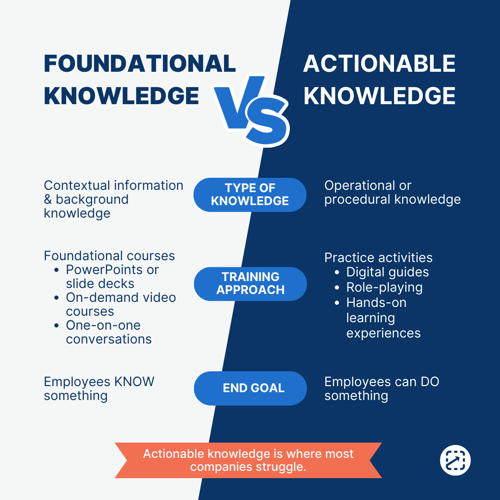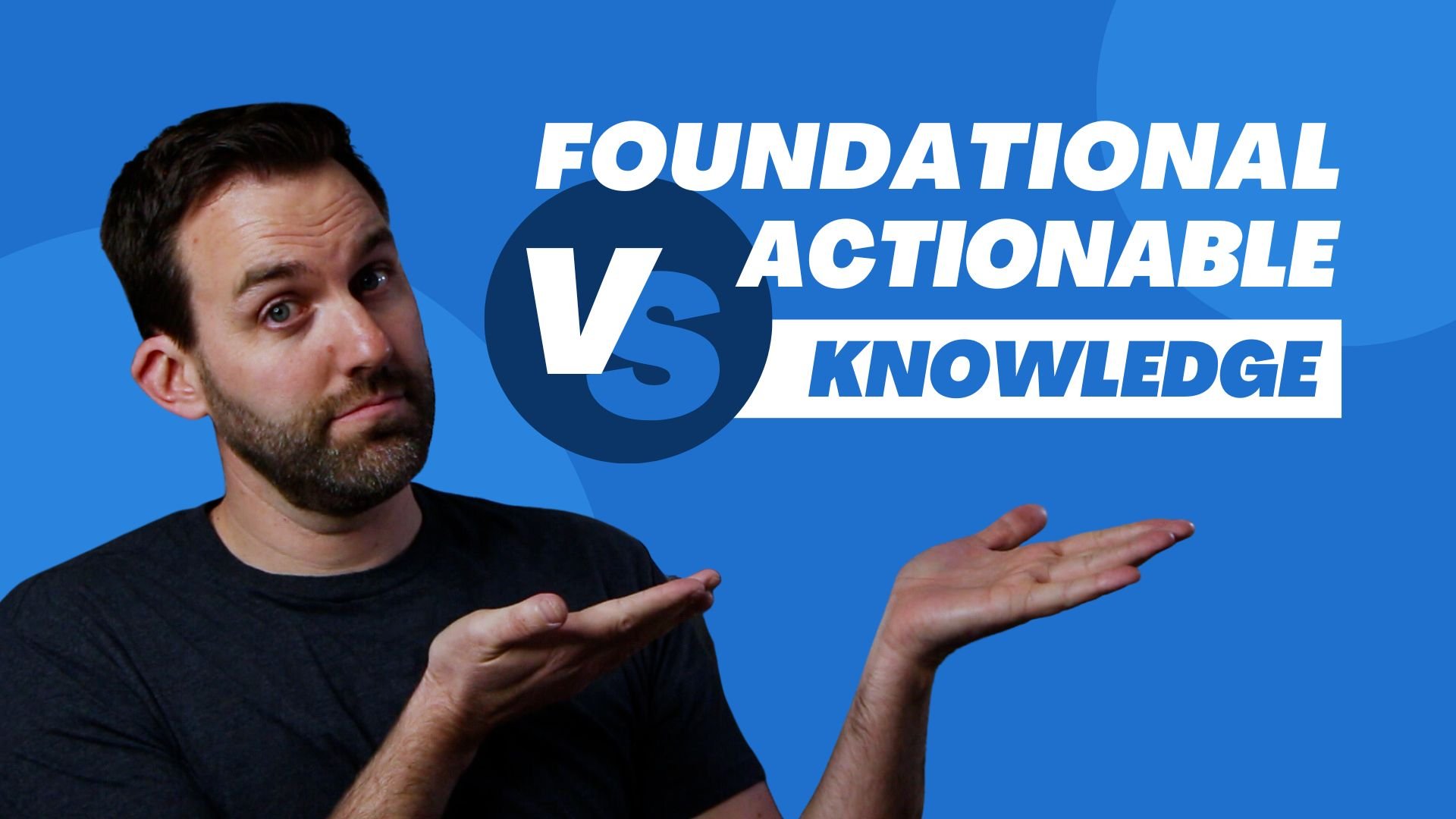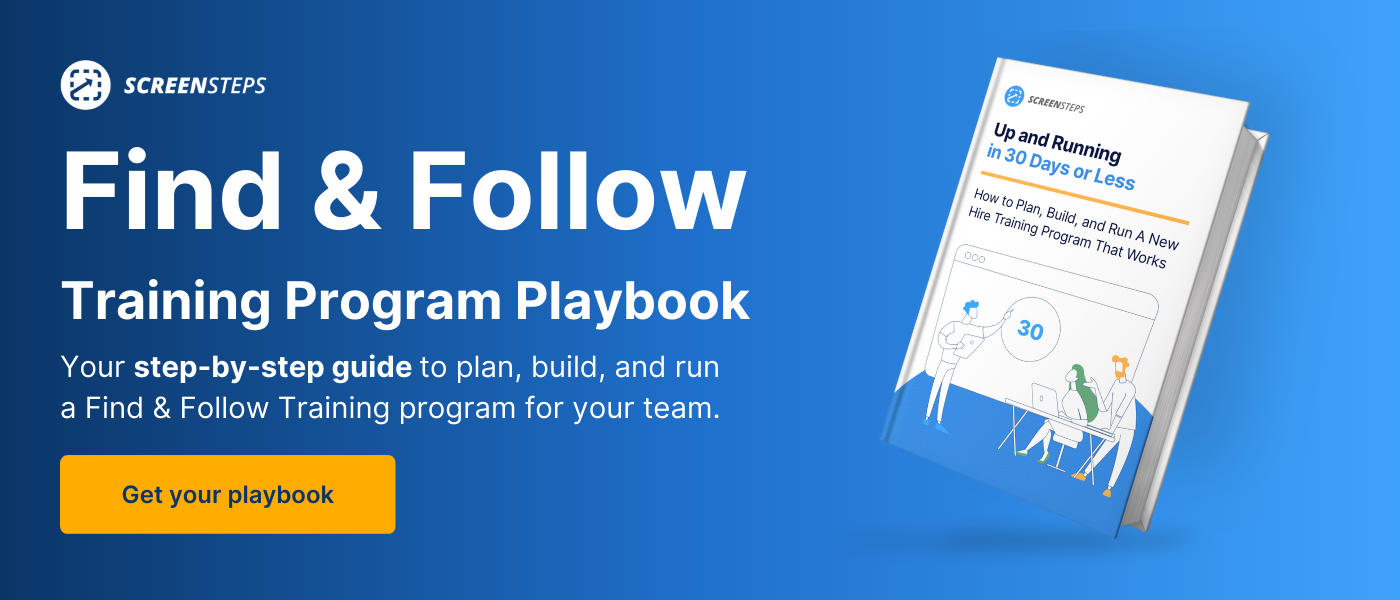Foundational vs Actionable Knowledge: How it Affects Employee Training
What is the difference between foundational and actionable knowledge? And do you separate these two when creating a training plan?
If not, chances are that you are using the wrong resources to teach different concepts in your employee training.
Over the past decade, I’ve helped companies build employee training programs. Specifically, I’ve taught the Find & Follow Framework, a method we developed for our knowledge ops platform, ScreenSteps. With it, we’ve helped companies train their employees 50% faster.
And that process starts by separating your foundational and actionable knowledge.
You need both to train your employees so that they become confident, efficient, and independent workers.
Watch this 3-minute video for a quick overview of foundational and actionable knowledge. Then read further to get a deeper explanation of the differences between foundational and actionable knowledge.
Foundational knowledge
Foundational knowledge is contextual knowledge. It provides your employees with the background information they need to confidently follow step-by-step instructions.
So your foundational knowledge is laying the groundwork, teaching employees basic skills, and relaying important contextual information. This provides a foundation the employees can quickly build on as they leave training and enter the workforce.
This isn’t a memorization exercise. Typically, foundational knowledge provides learners with enough information to talk about a topic, but not enough to take action or handle tasks.
When your employees gain foundational knowledge, they are better able to react to different situations and learn in their jobs.
For example, if you wanted to learn to build furniture, then your foundational knowledge is learning about the different tools you would use to build that furniture.
You’d have to understand when to grab a hammer vs. a screwdriver. You’d need to know how to use the saw and other tools. You just need to be able to identify parts and how to use them.
How to transfer foundational knowledge
Your foundational knowledge is your big-picture overview. When you create your foundational knowledge resources, you don’t want to go into too much detail.
The goal is to provide enough information so that your employees develop a base knowledge that they can build on in the workflow.
Some ways to transfer foundational knowledge include:
- 10-20 minute lectures
- Videos
- On-demand courses
- Learning management system (LMS)
Actionable knowledge
Actionable knowledge is the operational and procedural knowledge. This is the knowledge that enables your employees to take action. Employees can DO something with this knowledge.
And, FYI, this is where most businesses struggle.
With your foundational knowledge in place, employees can follow digital guides to handle situations on their own.
Typically, this knowledge is documented in cloud-based software, like a knowledge base, knowledge ops platform, or other knowledge management systems.
The reason you are training employees to use digital guides for actionable knowledge is it is constantly changing. For example, at some point, you will need to update a date in your guides, add a new step to a procedure, etc.
Your employees can adapt quickly to change if their foundational knowledge and habits are to find and follow digital guides. Then they can complete their tasks independently.
In our furniture building example, your actionable knowledge would be the step-by-step instructions on how to build the furniture. It is the instructions on when and where to measure, cut, sand, and piece together the furniture.
Your actionable knowledge is the how-tos and step-by-step instructions.
How to transfer actionable knowledge
Your actionable knowledge should be created in a way that employees can quickly find and reference that information while they are in their workflow. This is especially important if your employees are in a customer-facing role.
That’s why your actionable knowledge is documented in digital guides.
Some digital guide and documentation examples include:
- Job aids
- How-to guides
- Reference guides
- Call flows
- Step-by-step procedures
WARNING
Don’t put your actionable knowledge into videos! It is too difficult and time-consuming for employees to go back, watch the video, and find the specific spot where they need assistance.
Separate foundational and actionable knowledge before creating your employee training curriculum
Why is it important to separate foundational and actionable knowledge before you build your employee training curriculum?
When you separate foundational and actionable knowledge, you have a clear plan for how to transfer knowledge most efficiently.
It makes it easier to determine what type of resource you need to create for that information.
Do you need them to KNOW something? Then it is part of your foundational knowledge, so you’ll include it in your foundational training course.
Do you need them to DO something? Then you’ll create a guide that is easy for your employees to find, follow, and scan while they are doing the job.
Ultimately, the real purpose for separating the knowledge is to set everybody up for success on the job.
Revamp your training plan to produce more confident, efficient, and independent employees
When you separate foundational and actionable knowledge, you are better able to create an employee training plan that teaches employees the skills they need to do their jobs independently.
Need more tips on how to develop an employee training curriculum?
At ScreenSteps, we developed the Find & Follow Framework to help companies transfer knowledge more efficiently to their employees. This plan has helped companies train employees 50% faster.
Download our free Find & Follow eBook. It will walk you through the Find & Follow Framework so you can build your own knowledge transfer plan and start training more confident, efficient, and independent employees.


.png)
